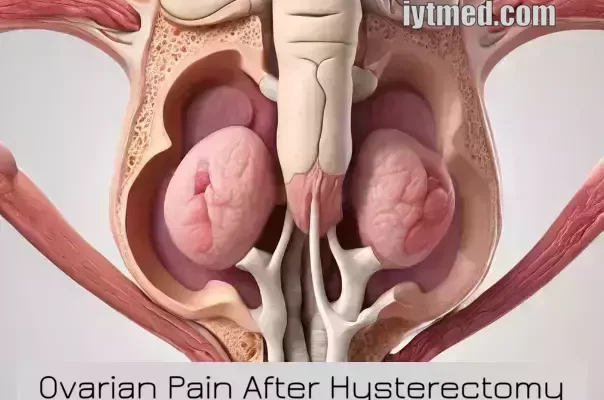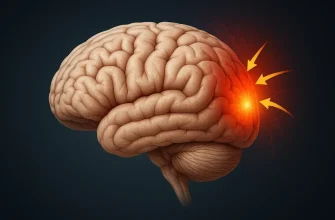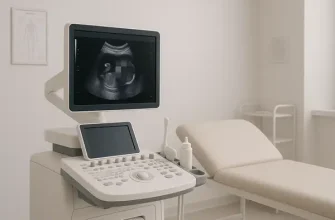For women who have had a hysterectomy, pain in the ovaries after the procedure might be concerning. A hysterectomy is a surgical operation in which the uterus and perhaps the ovaries are removed. It is crucial to realize that the removal of the ovaries during this treatment may lead to a decrease in hormone production, which might cause symptoms that resemble those of menopause. However, some women may have post-procedural ovarian pain even if the ovaries are not removed.
Acquiring understanding about the possible causes of post-hysterectomy ovarian pain is crucial. Adhesions or the development of scar tissue after surgery may be the cause of this pain. Internal organs may be connected by adhesions, which can cause pain or discomfort. Ovarian cysts, which may develop on the surviving ovary or within the scar tissue, are another possible reason.
Besides adhesions and ovarian cysts, pelvic floor muscle tension or spasms can also be a factor in causing ovarian pain. These muscles play a role in supporting the reproductive organs and may become tense or contracted following surgery, resulting in discomfort.
Causes of Ovarian Pain After Hysterectomy
After a hysterectomy, some women may experience ovarian pain, says Reyus Mammadli. This discomfort can have various causes and may be related to the surgical procedure itself or other underlying conditions. Here are some common causes of ovarian pain after a hysterectomy:
- Ovarian cysts: These fluid-filled sacs can develop on the ovaries and cause pain. They may be present before the hysterectomy or develop afterward.
- Adhesion formation: After surgery, scar tissue known as adhesions can form and attach to nearby organs or tissues, including the ovaries. This can result in pain and discomfort.
- Endometriosis: This condition involves the growth of uterine tissue outside the uterus, including on the ovaries. Even after a hysterectomy, endometriosis can still cause ovarian pain.
- Ovarian remnant syndrome: In some cases, a small piece of ovarian tissue may accidentally be left behind during a hysterectomy. This tissue can continue to produce hormones and cause pain.
- Infections: Although uncommon, infections in the pelvic region can cause ovarian pain after surgery.
Symptoms of Ovarian Pain After Hysterectomy
Symptoms of ovarian pain after a hysterectomy can vary in severity and presentation. While not all women may experience the same symptoms, there are several common signs to watch out for.
One of the most prevalent symptoms is pelvic pain, which can range from mild discomfort to severe cramping. This pain may be constant or intermittent and may radiate to the lower back or thighs. Some women also report feeling a sharp, stabbing pain in the pelvis.
In addition to pelvic pain, women may also experience bloating and abdominal discomfort. This can make them feel full quickly or lead to a sensation of pressure in the abdomen. Changes in bowel movements, such as constipation or diarrhea, may also occur.
Other potential symptoms of ovarian pain after a hysterectomy include abnormal vaginal bleeding, increased urinary frequency or urgency, and pain during sexual intercourse. Some women might also experience mood swings, fatigue, and difficulty sleeping.
Diagnosis of Ovarian Pain After Hysterectomy
Diagnosing the cause of ovarian pain after a hysterectomy is crucial in order to provide appropriate treatment and alleviate the discomfort experienced by the patient. Healthcare professionals will employ several methods to make an accurate diagnosis.
Physical exam
During a physical exam for ovarian pain after a hysterectomy, the healthcare provider will carefully evaluate the patient’s abdomen and pelvis. This includes palpating or gently pressing on the areas of discomfort to identify any abnormalities or tenderness, states iytmed.com. They may also perform a pelvic exam by using a speculum to examine the vagina and cervix.
Physical exams are essential in determining the presence of any physical signs that may indicate potential causes of ovarian pain after a hysterectomy. For example, if there is increased tenderness or swelling in the lower abdomen, it could suggest an infection or inflammation.
Additionally, during the exam, the healthcare provider will assess other abdominal organs such as the bladder and intestines to ensure their proper functioning. This can help rule out any other conditions that might contribute to the ongoing pain.
Pelvic ultrasound
Pelvic ultrasound is a non-invasive imaging technique commonly used to evaluate the pelvic organs, including the ovaries, after a hysterectomy. During this procedure, high-frequency sound waves are transmitted through a transducer and into the pelvic area to create images of the internal structures.
Pelvic ultrasound plays a crucial role in diagnosing ovarian pain after a hysterectomy. It allows healthcare providers to visualize the ovaries and assess for any abnormalities or changes in size, shape, or position. The images obtained through pelvic ultrasound can help determine if there are any cysts, masses, or other conditions that may be causing the ovarian pain.
Moreover, pelvic ultrasound can also provide important information about the blood flow to the ovaries. This information aids in identifying conditions such as ovarian torsion or ovarian cyst rupture, which may result in intense pain.
The procedure is safe and painless. Patients lie on an examination table while a technologist gently moves the transducer over their lower abdomen. Gel is applied to improve contact between the transducer and skin, allowing for better sound wave transmission and clearer images.
CT scans or MRI
CT scans or MRI (Magnetic Resonance Imaging) are diagnostic imaging techniques commonly used to help diagnose and evaluate the cause of ovarian pain after a hysterectomy. These non-invasive procedures provide detailed images of the internal structures of the body, allowing healthcare professionals to identify any abnormalities or issues related to the ovaries.
CT scans use X-rays and computer technology to create cross-sectional images of the body. It can help detect conditions such as cysts, tumors, or adhesions that may be causing ovarian pain. CT scans are particularly useful in providing information about the size, location, and density of abnormalities.
On the other hand, MRI uses a magnetic field and radio waves to produce detailed images of the body’s soft tissues. This imaging technique is especially helpful in identifying changes in the ovaries, such as tumors or lesions. It can also help determine if there are any signs of infection or inflammation.
Treatment Options for Ovarian Pain After Hysterectomy
Treatment options for ovarian pain after hysterectomy depend on the underlying cause of the pain. Here are some common treatment options that may be considered:
- Pain Medications: Over-the-counter pain relievers such as ibuprofen or acetaminophen can help manage mild to moderate ovarian pain. In more severe cases, stronger prescription medications may be prescribed.
- Hormone Therapy: If the pain is due to hormonal imbalances, hormone replacement therapy (HRT) may be recommended. HRT can help regulate hormone levels and alleviate pain symptoms.
- Physical Therapy: Pelvic floor physical therapy can help relieve ovarian pain by improving pelvic muscle strength and reducing tension in the pelvic area.
- Surgical Interventions: In some cases, surgical interventions may be necessary to address the underlying cause of ovarian pain. This could include procedures such as laparoscopy to remove adhesions or cysts.
- Lifestyle Modifications: Making certain lifestyle changes, such as managing stress, maintaining a healthy weight, and practicing relaxation techniques, may help reduce ovarian pain and improve overall well-being.
Preventing Tips for Ovarian Pain After Hysterectomy
To prevent ovarian pain after a hysterectomy, it is important for patients to follow certain guidelines and take necessary precautions. Here are some tips to help minimize the risk of experiencing post-hysterectomy ovarian pain:
- Follow the doctor’s instructions: Always adhere to the post-operative care instructions provided by your surgeon. This may include avoiding activities like heavy lifting or strenuous exercise that could strain your abdomen.
- Take prescribed pain medication: If your doctor prescribes pain medication, be sure to take it as directed. This can help manage any discomfort during the recovery period and reduce the chances of developing ovarian pain.
- Prioritize rest and relaxation: Allow yourself ample time to rest and recover after surgery. Avoid exhausting activities that could potentially trigger ovarian pain or complications.
- Stay hydrated: Drinking plenty of water helps maintain overall health and prevents constipation, which can contribute to pelvic discomfort after a hysterectomy.
- Maintain a healthy lifestyle: Adopting a balanced diet and engaging in regular exercise may aid in preventing complications such as ovarian cyst formation or adhesions.
- Attend follow-up appointments: Regularly attend scheduled follow-up visits with your healthcare provider for proper monitoring of your healing progress.
By following these preventive measures, patients can reduce the risk of experiencing ovarian pain or related complications after undergoing a hysterectomy procedure. It is always recommended to consult with a healthcare professional regarding any concerns or questions about post-operative care.









